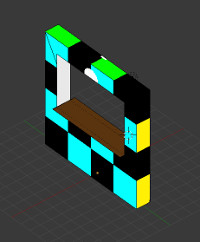
Things were a bit slow this month due to christmas but there were still a large number changes made this month internally.


Previously windows were a flat texture cut out of the wall texture. This made adding new wall types harder and limited windows to only one type.
Windows are now implemented using multi-textured static models, special textures get replaced with the correct wall texture at runtime based on placement.
Implementing this required a bit of work to efficiently store the type of window for a wall without increasing the size of WallInfo which each tile in the level has two, making every little addition to the structure greatly increase the memory required. The ResourceKey structure used to name resources was too large to store in the WallInfo struct (about 64 bytes on 64 bit machines). Instead of storing it directly the level now keeps a map of key to a 8 bit id which is stored instead, this limits the number of unique types of windows to 256 but that should be more than enough for now.
When selecting a staff member a new option to move them has been added. This has an added effect (which has also been added to the initial placement of a staff member as well) of forcing the entity to be owned by the room they are placed into. Rooms’ scripts have been updated to remove extra staff members they don’t care about or need.
Instead of falling off into a black void the map has some padding at edge, its pretty empty and uninteresting at the moment but hopefully I will be able to improve this later. Along with this change the camera was clamped as well.

Rooms now can have detailed tooltips. Currently only used for the registration office to display the number of staff but can be used for anything. The idea for this is to allow rooms to display the current state of the room and any issues so that the player can react to them.
The building on the main menu has been improved with a few new objects and two rooms built. Minor changes but it does help with the look a lot.
Scripts can now create notifications to alert the player about issues within a room. This required a bit of work to allow the server side script to notify a remote player whilst also allowing them to have full control over the look of it. To handle this, scripts can encode data to be sent to the client and be decoded by the script on the the client where it can create the UI elements required.
Scripts can also control the tooltips displayed when hovering over a room. This works like above but has the client request the server to generate the tooltip instead of the server pushing to the client.
Bitable type has been removed. For networking the Bitable trait was used to allow types to be encoded into packets with control at the bit level instead of byte. delta-encode can be set to always encode a type effectively disabling the delta encoding handling. This ended up being easier to use due to the derive support than manually implementing Bitable so all previous use cases have been changed to use delta-encode.lua_error. I’ve worked around this by using a c wrapper function that calls into the rust function and invokes lua_error based on the return value of the rust function. Not the nicest work around but it works and doesn’t rely on how unwinding is implemented in rust.Angle type to handle angles. Previously I just used a f32 but kept encountering issues due to the value not always being within the same range (if it was even kept within a range). This type keeps the value within -PI,PI wrapping if needed. This ended up fixing a few issues where entities could end up spinning.Huh, this is a new bug #gamedev #indiedev pic.twitter.com/mWgVU1y1YE
— Thinkofname (@thinkofdeath) December 20, 2017
I haven’t been streaming my work on twitch here lately but sometimes I will pop up and stream for a bit. Feel free to stop by and watch if I’m streaming.
I’ve opened a subreddit for the game as per someones suggestion. It’s mostly empty currently but hopefully that’ll change once I get some time to put some work into it. Here